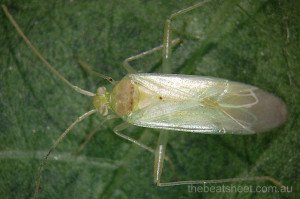Mirids are highly mobile and a key pest of mungbeans and cotton, although they can occur in many other crops. While there are quite a few mirid-like bugs, such as apple dimpling bug, brokenbacked bug and brown smudge bug, the primary pest species are green mirid (Creontiades dilutus), brown mirid (Creontiades pacificus) and crop mirid (Sidnia kinbergi).

Green mirid adult
Green mirids are a native species widely distributed across Australia. Adults are 7 mm long, pale green, often with red markings and have clear wings folded flat on the back. Adults and nymphs are very mobile with antennae nearly as long as the body. Green mirid nymphs have a pear-shaped body and the tips of the antennae are reddish brown.
Brown mirids have been recorded from northern New South Wales and Queensland. It is distributed in Eastern Asia, including China and Micronesia. They are similar in shape to green mirids, but the adults may be slighly larger (8 mm), and the front part of the body is brown instead of green when viewed from the top (i.e. the head and thorax). The nymphs have banded antennae, alternating red-brown and white.
Crop mirids have been reported from all Australian states except the Northern Territory. Adults are 7 mm long, grey-green on top and bright green underneath. Nymphs are green with brown and white striped antennae and a black spot on the back.
Hosts and damage
Mirids feed and develop on a wide range of host plants, including cotton, summer pulses, sunflowers, safflower, lucerne and many other legumes, and weed species including wild turnips, verbena, noogoora burr and thistles. During the winter months they are often difficult to locate, overwintering as adults or eggs on wild plants in low numbers. However, as temperatures begin to rise in August, their populations increase. The primary movement of mirids into summer crops occurs during November as nearby alternative host plants dry off and the insects seek a fresh food source. There is also evidence of long distance migration, possibly from inland areas, associated with weather fronts. This may be the cause of some of the widespread and repeated influxes of mirids sometimes observed in grain and cotton growing regions early in the summer.
Adults and nymphs pierce plant tissue and release a chemical that destroys cells in the feeding zone. In cotton, growing points can be killed resulting in increased branching. Squares, buds, flowers and small bolls can be shed, decreasing yield potential. Boll feeding in cotton can reduce lint yield and quality. In legume crops, mirids may also attack more mature pods, feeding on and damaging the seeds inside without causing shedding.
Life cycle
Within a crop, mirids lay eggs singly, preferentially on the leaf petiole. The egg is inserted into the plant tissue with an oval egg cap projecting above the leaf or petiole surface. Eggs hatch after 7-10 days depending on temperature; at 30-32ºC (average temperature) eggs hatch within 4-5 days and there are five nymphal instars, each of about 2-3 days duration. Under summer conditions, a generation (egg to adult) can be completed in about three weeks. Adults can live for 3-4 weeks.
Mirid populations may vary significantly with climatic conditions. In sustained hot weather (three consecutive days above 35°C), numbers may decrease. Numbers will also tend to be lower immediately after heavy rains or storms, although storm fronts may bring early season influxes of adults.
Management notes
In insecticide resistance surveillance conducted by NSW DPI and supported by CRDC, no resistance was detected in green mirids to fipronil, sulfoxaflor or clothianidin during the 2023/24 season.
Mirids are known to survive on weeds and native host plants in broadacre farming areas. They are also known to breed on native hosts in inland (central) Australia in winter, and can migrate to cropping areas in spring in a similar way to the native budworm, Helicoverpa punctigera. It is thought that this is one of the reasons why insecticide resistance has not been detected, i.e. there is a continual influx of mirids into cropping areas from outside that have never experienced selection pressure for insecticide resistance.
If possible, minimise flowering duration by optimising water management. Check crops twice weekly from budding until post-flowering:
- inspect visually or use a beat sheet
- avoid sampling in windy conditions.
Although predatory bugs and spiders are known to feed on mirid adults, nymphs and eggs, there are no beneficial species that are recognised to be regulators of mirid populations.
Further information
- Pictures of mirid lifestages in the Beatsheet’s image gallery
- Download the Beatsheet’s A3 ID guide of mirid-like bugs
- Green mirids (cesar PestNotes)
- Registered chemicals database—Australian Pesticides and Veterinary Medicines Authority (APVMA)
- Mirids in cotton (video series from CottonInfo)
Beatsheet posts with a focus on mirids:
- Improved mirid spray thresholds for cotton
- New APVMA permit for use of dimethoate to control mirids in faba beans.
- Confirmation of green mirid damage potential in faba beans
- Plant-based and dynamic thresholds for mirids in early stage cotton.
- Mirid research trials on the Darling Downs
- Mirids in Mungbeans
- Insurance spray for mirids in Bollgard II
